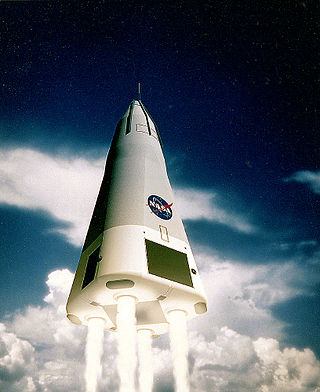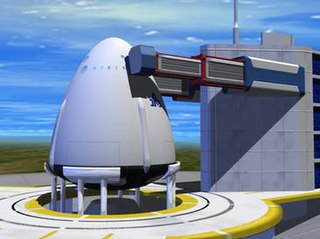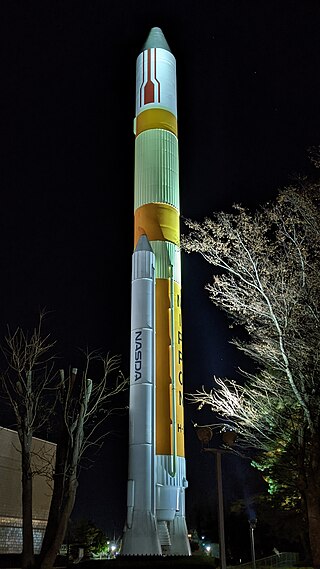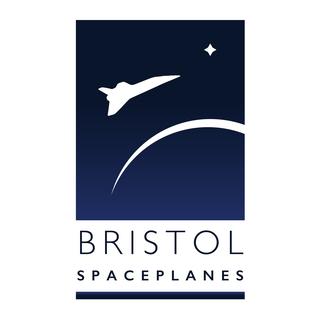Related Research Articles

The aerospike engine is a type of rocket engine that maintains its aerodynamic efficiency across a wide range of altitudes. It belongs to the class of altitude compensating nozzle engines. Aerospike engines were proposed for many single-stage-to-orbit (SSTO) designs. They were a contender for the Space Shuttle main engine. However, as of 2023 no such engine was in commercial production, although some large-scale aerospikes were in testing phases.
Human spaceflight programs have been conducted, started, or planned by multiple countries and companies. The age of manned rocket flight was initiated by Fritz von Opel who piloted the world's first rocket-propelled flight on 30 September 1929. All space flights depend on rocket technology; von Opel was the co-designer and financier of the visionary project. Until the 21st century, human spaceflight programs were sponsored exclusively by governments, through either the military or civilian space agencies. With the launch of the privately funded SpaceShipOne in 2004, a new category of human spaceflight programs – commercial human spaceflight – arrived. By the end of 2022, three countries and one private company (SpaceX) had successfully launched humans to Earth orbit, and two private companies had launched humans on a suborbital trajectory.

A reusable launch vehicle has parts that can be recovered and reflown, while carrying payloads from the surface to outer space. Rocket stages are the most common launch vehicle parts aimed for reuse. Smaller parts such as rocket engines and boosters can also be reused, though reusable spacecraft may be launched on top of an expendable launch vehicle. Reusable launch vehicles do not need to make these parts for each launch, therefore reducing its launch cost significantly. However, these benefits are diminished by the cost of recovery and refurbishment.

A spaceplane is a vehicle that can fly and glide like an aircraft in Earth's atmosphere and maneuver like a spacecraft in outer space. To do so, spaceplanes must incorporate features of both aircraft and spacecraft. Orbital spaceplanes tend to be more similar to conventional spacecraft, while sub-orbital spaceplanes tend to be more similar to fixed-wing aircraft. All spaceplanes to date have been rocket-powered for takeoff and climb, but have then landed as unpowered gliders.

The Lockheed Martin X-33 was a proposed uncrewed, sub-scale technology demonstrator suborbital spaceplane that was developed for a period in the 1990s. The X-33 was a technology demonstrator for the VentureStar orbital spaceplane, which was planned to be a next-generation, commercially operated reusable launch vehicle. The X-33 would flight-test a range of technologies that NASA believed it needed for single-stage-to-orbit reusable launch vehicles, such as metallic thermal protection systems, composite cryogenic fuel tanks for liquid hydrogen, the aerospike engine, autonomous (uncrewed) flight control, rapid flight turn-around times through streamlined operations, and its lifting body aerodynamics.

The DC-X, short for Delta Clipper or Delta Clipper Experimental, was an uncrewed prototype of a reusable single-stage-to-orbit launch vehicle built by McDonnell Douglas in conjunction with the United States Department of Defense's Strategic Defense Initiative Organization (SDIO) from 1991 to 1993. Starting 1994 until 1995, testing continued through funding of the US civil space agency NASA. In 1996, the DC-X technology was completely transferred to NASA, which upgraded the design for improved performance to create the DC-XA. After a test flight of DC-XA in 1996 resulted in a fire, the project was canceled. Despite its cancellation, the program inspired later reusable launch systems with Elon Musk stating the SpaceX Falcon 9 development was "... continuing the great work of the DC-X project." Michael D. Griffin has since praised the program as "government R&D at its finest."
Rocketplane Limited, Inc. was a spacecraft design and development company headquartered in De Pere, Wisconsin. After filing for bankruptcy, the company reincorporated as Rocketplane Global Inc.

The Kankoh-maru is a proposed vertical takeoff and landing (VTVL), single-stage-to-orbit (SSTO), reusable launch system. According to a document from July 1997, it would have been manufactured by Kawasaki Heavy Industries and Mitsubishi Heavy Industries, with its formal name being the Kawasaki S-1.

XCOR Aerospace was an American private spaceflight and rocket engine development company based at the Mojave Air and Space Port in Mojave, California, Midland International Air and Spaceport in Midland, Texas and the Amsterdam area, the Netherlands. XCOR was formed in 1999 by former members of the Rotary Rocket rocket engine development team, and ceased operations in 2017.

The Intermediate eXperimental Vehicle (IXV) is a European Space Agency (ESA) experimental suborbital re-entry vehicle. It was developed to serve as a prototype lifting body orbital return vehicle to validate the ESA's work in the field of reusable orbital return vehicles.

The H-II (H2) rocket was a Japanese satellite launch system, which flew seven times between 1994 and 1999, with five successes. It was developed by NASDA in order to give Japan a capability to launch larger satellites in the 1990s. It was the first two-stage liquid-fuelled rocket Japan made using only technologies developed domestically. It was superseded by the H-IIA rocket following reliability and cost issues.

The XCOR Lynx was a proposed suborbital horizontal-takeoff, horizontal-landing (HTHL), rocket-powered spaceplane that was under development by the California-based company XCOR Aerospace to compete in the emerging suborbital spaceflight market. The Lynx was intended to carry one pilot, a ticketed passenger, and/or a payload above 100 kilometres (62 mi) altitude. The concept was under development since 2003, when a two-person suborbital spaceplane was announced under the name Xerus.

SpaceLiner is a concept for a suborbital, hypersonic, winged passenger supersonic transport, conceived at the German Aerospace Center in 2005. In its second role the SpaceLiner is intended as a reusable launch vehicle (RLV) capable of delivering heavy payloads into orbit.
Aircraft can have different ways to take off and land. Conventional airplanes accelerate along the ground until sufficient lift is generated for takeoff, and reverse the process to land. Some airplanes can take off at low speed, this being a short takeoff. Some aircraft such as helicopters and Harrier jump jets can take off and land vertically. Rockets also usually take off vertically, but some designs can land horizontally.
The BE-3 is a LH2/LOX rocket engine developed by Blue Origin.
The DARPA XS-1 was an experimental spaceplane/booster with the planned capability to deliver small satellites into orbit for the U.S. Military. It was reported to be designed to be reusable as frequently as once a day, with a stated goal of doing so for 10 days straight. The XS-1 was intended to directly replace the first stage of a multistage rocket by taking off vertically and flying to hypersonic speed and high suborbital altitude, enabling one or more expendable upper stages to separate and deploy a payload into low Earth orbit. The XS-1 would then return to Earth, where it could ostensibly be serviced fast enough to repeat the process at least once every 24 hours.

The H3 Launch Vehicle is a Japanese expendable launch system. H3 launch vehicles are liquid-propellant rockets with strap-on solid rocket boosters and are launched from Tanegashima Space Center in Japan. Mitsubishi Heavy Industries (MHI) and JAXA are responsible for the design, manufacture, and operation of the H3. The H3 is the world's first rocket to use an expander bleed cycle for the first stage engine.

Bristol Spaceplanes (BSP) is a British aerospace company based in Bristol, England, who has designed a number of spaceplanes with sub-orbital and orbital capabilities. The company's stated goal is "to realise low-cost access to space", primarily through reusable launch vehicles, claiming the cost of human space travel has the potential to be reduced by a factor of 1,000.
New Glenn is a heavy-lift orbital launch vehicle in development by Blue Origin, named after NASA astronaut John Glenn, the first American astronaut to orbit Earth. Design work on the vehicle began in 2012; illustrations of the vehicle, and the high-level specifications, were initially publicly unveiled in September 2016. New Glenn is a two-stage rocket with a diameter of 7 m (23 ft). Its first stage will be powered by seven BE-4 engines that are also being designed and manufactured by Blue Origin.
References
- ↑ Development of hardware-in-the-loop simulator for experimental Winged Rocket. Shirakata K., Yonemoto K., Yamasaki H., Ura Y., Minote H., Shiihara A., Ohmori S., Ishimoto S., Mugitani T. Asia-Pacific International Symposium on Aerospace Technology (APISAT 2015). Engineers Australia, 2015: 114-120. ISBN 9781922107480.
- 1 2 3 4 5 6 7 8 9 10 11 12 13 14 Koichi, Yonemoto; Takahiro, Fujikawa; Toshiki, Morito; Joseph, Wang; Ahsan r, Choudhuri (2018). "Subscale Winged Rocket Development and Application to Future Reusable Space Transportation". INCAS Bulletin. 10: 161–172. doi: 10.13111/2066-8201.2018.10.1.15 .
- 1 2 3 Report on Report on Report on the current state of "Japanese University Rocket Projects". University Space Engineering Consortium (UNISEC), Japan. October 2011.
- ↑ Surendra, G. Guna; Yonemoto, K.; Matsumoto, T.; Kutsuna, Y.; Itakura, K.; Yamasaki, H.; Ura, Y.; Ichigie, M.; Tanaka, H.; Ueno, S.; Someya, T. (2015). "Recent Developments of Experimental Winged Rocket: Autonomous Guidance and Control Demonstration Using Parafoil". Procedia Engineering. 99: 156–162. doi: 10.1016/j.proeng.2014.12.520 .
- ↑ RocketFirst Flight Test Results of Subscale Winged Rocket. ITAKURAK Yoshiro, Hiroshi YAMASAKI, Shintaro MIYAMOTO, Takaaki MATSUMOTO, and Koichi YONEMOTO. JAXA. 2013.
- ↑ Sakaguchi, Hiroyuki (2018). "Methane Engine Just for Future Space Transportation" (PDF). IHI Engineering Review. Japan: IHI Corporation. 51 (2): 16–19.
- ↑ "Team". Space Walker. Retrieved 27 April 2021.
- ↑ 東京理科大学との共同研究契約締結のお知らせ (in Japanese). Space Walker Inc. 17 April 2019. Retrieved 27 April 2021.
- ↑ サブオービタルスペースプレーンの打ち上げスケジュールの変更及びコンポーネント販売について (in Japanese). Space Walker Inc. 2 October 2020. Retrieved 27 April 2021.
- ↑ 【3/17正式版】有翼ロケット実験機「gaaboo(ガーブー)号」(WIRES#014-3A) 打ち上げ結果について (in Japanese). Space Walker Inc. 17 March 2020. Retrieved 27 April 2021.